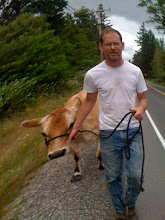Actually it is rather cold out. Colder than I can remember. What makes this interesting is not simply that it is a bit uncomfortable to be outside, but rather what happens unexpectedly. I will take great credit -- deserved or not -- for getting a barn ready for the cows before winter arrived. The fact that it took four years and therefore four winters is incidental to this discussion. The cows are not locked into their paddock to keep them barn bound for the week.
The most frustrating aspect of chill-milking is the milk hoses. Made of thick, hard, clear plastic, it has a comfort range. Twenty degrees and below is not within that comfort zone. It is now very hard and most inflexibly. Sadly, flexibility is its great attribute; it needs the ability to flex over the metal housings of the milking machine and the vacuum lines. Simply isn't happening on these chilly morns.
As it also happens, any moisture that remains in the vacuum lines most quickly freezes. With chunks of ice in the lines, the air cannot pass and therefore no vacuum. No vacuum, and the milk does not flow from the udders of the cows. Thankfully, the tea kettle is still warm in the kitchen and can assist in melting the lines.
Surround the barn are four three hundred gallon stock tanks filled with water from the roof of the barn. As it now happens, they are filled each with three hundred gallons of ice. Great for a cocktail party in August, but most difficult for three very thirsty Jerseys. I have been breaking the ice on top morning, noon and night trying to keep the small ice bergs from colonizing the entire tank.
Little Miss Andi, the youngest cow here came into heat on Saturday morning and Jorge and I walked her down to the neighboring farm to be bred to their Scottish Highland bull. I have great hope that this will do the trick this time. As Andi is a young heifer, she is most prone to get bred and should have no problem. Tomorrow we will return to pick her up and walk her back to her rather confused and lonely sister cows.
Those lonely cows are standing in the snow as I write this, staring over at me. I am most certainly projecting, but they appear to be confused by the snow, confused as to why there is no grass for them to graze. As their days are generally filled with walking the pastures and grazing, they have a great deal of free time on their hands. They chomp on the hay in the mangers, chew a little cud, but there is still many hours left for them. With luck the snow will melt in a few days and they can get back to their cow ways.





















